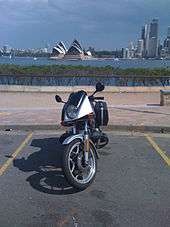BMW R65

The BMW R65 was a light touring motorcycle introduced by BMW in 1978 to add a mid-size motorcycle to its product line. The original R65, contrary to the views of some commentators has the same sized frame as the larger R series motorcycles, the R65 does however have a shorter swingarm than its siblings and therefore a shorter bolt-on rear sub-frame, this along with the shorter front forks and 18" front wheel gives the illusion that the R65 frame is smaller. The initial "model' R65 was manufactured until 1984. In 1985 the R65’s engine was put into the same frame and suspension as the R80 which featured a single rear shock absorber (mono-shock).[1] Additionally, between 1981 and 1984 the R65LS was manufactured. This R65 variant had a small triangular fairing that was designed by Hans Muth.[2]
Technical overview

The R65 is fitted with a type 248/1 engine, a different version of the well known BMW type 247, also known as an airhead. The engine is an 648 cc, OHV, two valves per cylinder, air-cooled flat-twin (i.e., horizontally-opposed cylinders) or "boxer" engine. The R65 weighs 205 kg (455 lb) with a full tank of fuel and has a five speed gearbox connected to a shaft final drive.[3] From 1981 on, the R65 was fitted with breaker-less electronic ignition. This further improved the already good reliability of the bike.
Following standard BMW practice of the time, two 32 mm Bing CV carburettors were used and the R65 used a single dry plate clutch. An additional lower powered version was also produced for the German market and was fitted with 26 mm Bing CV carburettors.
The R65 features a smaller fuel tank than other larger BMW airheads, with a 22 litres (4.8 imp gal; 5.8 US gal) capacity which includes a 0.5 gallon reserve.
The monolever version of the bike was produced from 1985 until 1993.
R65LS

In 1982 in an effort to enhance the R65’s image the Hans Muth designed R65LS was introduced. 6,389 R65LS bikes were produced, which featured a triangular shaped pod fairing and instrument housing versus the standard naked front end of the R65. Furthermore, a different rear seat featured pillion grab handles similar in style to the soon-to-be-introduced K Series BMWs. Different model transfers were used and the only colours were hennarot (red) and polaris (silver). Much of the chrome work of the R65 was replaced by black painted or black chrome features (exhaust piping, mufflers). Other features included:
- Twin disc front brakes in-lieu of single disc
- Lower front handlebars for a slightly more sporty seating position
- Different alloy wheel pattern - on red models painted white
- Different rear drum brake size
- Black chrome mufflers and black painted exhaust pipes
R65GS
In 1987, the R65GS was released, to become a member of the GS family of dual-sport bikes. The R65GS, of which 1,727 were produced,[4] featured the R65 engine fitted into a R80G/S chassis with a monolever combined drive/swingarm and single shock absorber.
Performance
The power output of early R65 models was 33 kW (44 hp) but from 1981 this increased to 37 kW (50 hp) at 7,250 rpm Similarly in 1981 torque rose from 50 N·m (37 ft·lbf) at 5,500 rpm to 52.3 N·m (38.6 ft·lbf) at 6,500 rpm.[5] This propelled both variants from 0–100 km/h (0–62 mph) in 5.8 seconds. The R65 could do the standing 400 metres (quarter mile) in 14.3 seconds and the standing kilometre (0.6 mile) in 28.1 seconds. The top speed of both variants was 175 km/h (109 mph). The lower powered version for the German market produced 27 hp (20 kW). Handling on the R65 is very nimble due to better frame geometry combined with a shorter wheelbase.
Tools and owner servicing were well thought out. The R65 came standard with a full tool kit, as well as a hand-operated tire pump. Owner maintenance is standard practice with these machines. Valve lash was adjusted by a simple set screw-and-locknut arrangement, and timing was taken care of by adjustment of the points' housing. On later models (i.e., model year 1981 onward), the points were no longer used and a Hall sensor was placed inside the housing, this housing behind the front engine cover is colloquially known as the 'bean can'. Most other maintenance tasks were easily achieved due to easy access to most mechanicals.
References
- ↑ Zimmerman, Mark & Nelson, Brian J. (2003). BMW Motorcycle Buyer's Guide. MotorBooks/MBI Publishing Company
- ↑ Zimmerman, Mark & Nelson, Brian J. (2003). BMW Motorcycle Buyer's Guide. MotorBooks/MBI Publishing Company
- ↑ "BMW R65 Specifications". BM Bikes. Retrieved 27 May 2010.
- ↑ "BMW R65GS Specifications". BM Bikes. Retrieved 4 June 2009.
- ↑ BMW R65 Rider's Handbook. BMW Motorrad GmbH+Co
External links
- BMW R bikes at DMOZ
- A Motorcycle Classics' article on the BMW R65LS.
- BMW R65 at How Stuff Works
- BMW R65 Monolever at BM Bikes